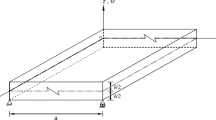Abstract
In this article mixed semi-analytical and analytical solutions are presented for a rectangular plate made of functionally graded (FG) material. All edges of a plate are under simply supported (diaphragm) end conditions and general stress boundary conditions can be applied on both top and bottom surface of a plate during solution. A mixed semi-analytical model consists in defining a two-point boundary value problem governed by a set of first-order ordinary differential equations in the plate thickness direction. Analytical solutions based on shear-normal deformation theories are also established to show the accuracy, simplicity and effectiveness of mixed semi-analytical model. The FG material is assumed to be exponential in the thickness direction and Poisson’s ratio is assumed to be constant.




Similar content being viewed by others
References
Anderson, T.A.: A 3D elasticity solution for a sandwich composite with functionally graded core subjected to transverse loading by a rigid sphere. Compos. Struct. 60, 265–274 (2003)
Bodaghi, M., Saidi, A.R.: Levy-type solution for bending analysis of thick functionally graded rectangular plates based on higher-order shear deformation plate theory. Appl. Math. Model. 34, 3659–3670 (2010)
Chakraborty, A., Gopalakrishnan, S.: A spectrally formulated finite element for wave propagation analysis in functionally graded beams. Int. J. Solids Struct. 40, 2421–2448 (2003)
GhannadPour, S.A.M., Alinia, M.M.: Large deflection behaviour of functionally graded plates under pressure loads. Compos. Struct. 75, 67–71 (2006)
Han, F., Pan, E., Roy, A.K., Yue, Z.Q.: Response of piezoelectric, transversely isotropic, functionally graded and multilayered half spaces to uniform circular surface loadings. Comput. Model. Eng. Sci. 14(1), 15–30 (2006)
Kang, Y.A., Li, X.F.: Bending of functionally graded cantilever beam with power-law non-linearity subjected to an end force. Int. J. Non Linear Mech. 44, 696–703 (2009)
Kant, T., Ramesh, C.K.: Numerical integration of linear boundary value problems in solid mechanics by segmentation method. Int. J. Num. Meth. Eng. 17, 1233–1256 (1981)
Kant, T., Gupta, A.V., Pendhari, S.S., Desai, Y.M.: Elasticity solution for cross-ply composite and sandwich laminates. Compos. Struct. 83, 13–24 (2008)
Kantrovich, L.V., Krylov, V.I.: Approximate Methods of Higher Analysis, 3rd edn. Noordhoff, Groningen (1958)
Kashtalyan, M.: Three-dimensional elasticity solution for bending of functionally graded rectangular plates. Eur. J. Mech. 23, 853–864 (2004)
Khabbaz, R.S., Manshadi, B.D., Abedian, A.: Nonlinear analysis of FGM plates under pressure loads using the higher-order shear deformation theories. Compos. Struct. 89, 333–344 (2009)
Ma, L.S., Wang, T.J.: Relationship between axisymmetric bending and buckling solution of FGM circular plates based on third-order plate theory and classical plate theory. Int. J. Solid Struct. 41, 85–101 (2004)
Matsunaga, H.: Stress analysis of functionally graded plates subjected to thermal and mechanical loading. Compos. Struct. 87, 344–357 (2009)
Nguyen, T.K., Sab, K., Bonnet, G.: First-order shear deformation plate models for functionally graded materials. Compos. Mater. 83, 25–36 (2008)
Pendhari, S.S., Kant, T., Desai, Y.M., Subbaiah, C.V.: On deformation of functionally graded narrow beams under transverse loads. Int. J. Mech. Mater. Des. 6, 269–282 (2010)
Praveen, G.N., Reddy, J.N.: Nonlinear transient thermoelastic analysis of functionally graded ceramic-metal plates. Int. J. Solids Struct. 35(33), 4457–4476 (1998)
Reddy, J.N.: Analysis of functionally graded plates. Int. J. Num. Meth. Eng. 47, 663–684 (2000)
Reddy, J.N., Chin, C.D.: Thermomechanical analysis of functionally graded cylinders and plates. J. Therm. Stress. 21, 593–626 (1998)
Sankar, B.V.: An elasticity solution for functionally graded beam. Compos. Sci. Tech. 61, 689–696 (2001)
Sankar, B.V., Tzeng, J.T.: Thermal stresses in functionally graded beams. AIAA J. 410(6), 1228–1232 (2002)
Shen, H.S.: Nonlinear bending response of functionally graded plates subjected to transverse loads and in thermal environments. Int. J. Mech. Sci. 44(3), 561–584 (2002)
Tanigawa, Y.: Some basic thermoelastic problems for non-homogeneous structural materials. Appl. Mech. Rev. 48(6), 287–300 (1995)
Vel, S.S., Batra, R.C.: Exact solution for thermoelastic deformations of functionally graded thick rectangular plates. AIAA J. 40(7), 1421–1433 (2002)
Woo, J., Meguid, S.A.: Nonlinear analysis of functionally graded plates and shallow shells. Int. J. Solids Struct. 38(42–43), 7409–7421 (2001)
Woo, J., Meguid, S.A., Stranart, J.C., Liew, K.M.: Thermo-mechanical postbuckling analysis of moderately thick functionally graded plates and shallow shells. Int. J. Mech. Sci. 47, 1147–1171 (2005)
Yang, J., Shen, H.S.: Nonlinear bending analysis of shear deformable functionally graded plates subjected to thermo-mechanical loads under various boundary conditions. Compos. B 34(2), 103–115 (2003)
Author information
Authors and Affiliations
Corresponding author
Appendix
Appendix
The coefficients of matrix [A] are,
where, \( \bar{E}_{h} = \left( {\frac{{E_{o} }}{{1 - \upsilon^{2} }}} \right)e^{\lambda } \quad {\text{and}}\quad \bar{E}_{o} = \frac{{E_{o} }}{{(1 - \upsilon^{2} )}} \) and A i,j = A j,i, (i, j = 1 to 11)
The coefficients of matrix [B] are,
and B i,j = B j,i (i, j = 1 to 4)
[D] and [E] matrix are same as [B] matrix.
The coefficients of vector {I} are
The coefficients of matrix [X] are
in which, \( \alpha = \frac{m\pi }{a} \) and \( \beta = \frac{n\pi }{b} \) and X i,j = X j,i, (i, j = 1 to 12)
Rights and permissions
About this article
Cite this article
Pendhari, S.S., Kant, T., Desai, Y.M. et al. Static solutions for functionally graded simply supported plates. Int J Mech Mater Des 8, 51–69 (2012). https://doi.org/10.1007/s10999-011-9175-1
Received:
Accepted:
Published:
Issue Date:
DOI: https://doi.org/10.1007/s10999-011-9175-1



